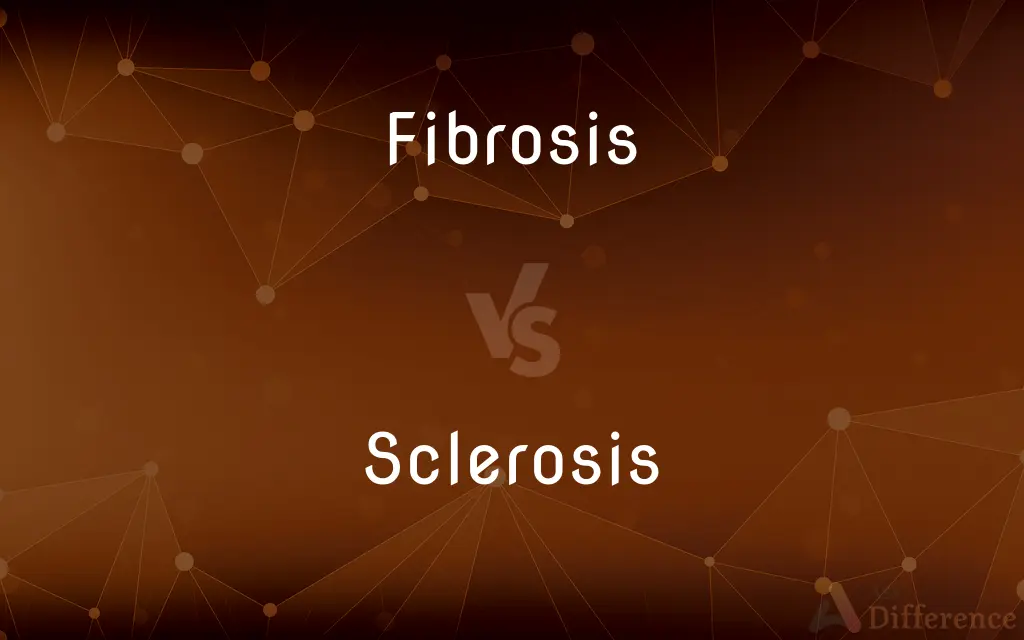Fibrosis vs. Sclerosis — What's the Difference?
By Maham Liaqat & Fiza Rafique — Updated on March 19, 2024
Fibrosis involves tissue thickening from excess fibrous connective tissue, whereas sclerosis is hardening of tissue, often from excessive collagen or scarring.

Difference Between Fibrosis and Sclerosis
Table of Contents
ADVERTISEMENT
Key Differences
Fibrosis is characterized by the accumulation of excess fibrous connective tissue in an organ or tissue, leading to thickening and scarring. This process can occur as a result of injury, inflammation, or disease, affecting organs like the lungs, liver, and heart, and impairing their function. On the other hand, sclerosis refers to the hardening of tissue or organs, primarily due to an overproduction of collagen or scarring. This condition is commonly associated with diseases such as multiple sclerosis, where the nervous system's myelin sheaths harden, and atherosclerosis, involving arterial wall hardening.
While fibrosis can affect various organs and lead to conditions like pulmonary fibrosis or liver cirrhosis, it is often reversible if the underlying cause is addressed. Sclerosis, however, typically indicates a more severe and often irreversible process, as it involves the hardening and loss of elasticity in tissues or organs, which can significantly impair their function.
Fibrosis may present with symptoms related to the affected organ, such as shortness of breath in pulmonary fibrosis or liver enlargement in hepatic fibrosis. Sclerosis symptoms, on the other hand, vary widely depending on the affected body part, ranging from neurological impairments in multiple sclerosis to reduced blood flow and chest pain in coronary artery disease.
The diagnosis of fibrosis often involves imaging techniques like X-rays or CT scans to identify tissue thickening, along with biopsy to assess the extent of fibrous tissue accumulation. For sclerosis, diagnosis may also include imaging studies, but it places a greater emphasis on identifying tissue hardening and its impact on organ function, often requiring specialized tests based on the affected organ system.
Treatment options for fibrosis typically focus on stopping the progression of tissue thickening and managing symptoms, which may include medications like corticosteroids or antifibrotic agents. In contrast, treatment for sclerosis aims to manage symptoms and slow the progression of tissue hardening, with options varying greatly depending on the specific type of sclerosis, ranging from immunomodulatory drugs in multiple sclerosis to surgical interventions in cases of arterial sclerosis.
ADVERTISEMENT
Comparison Chart
Definition
Accumulation of excess fibrous connective tissue in an organ or tissue.
Hardening of tissue or organs, often due to excessive collagen or scarring.
Commonly Affected Areas
Lungs, liver, heart, skin.
Nervous system, arteries, various organs depending on the type of sclerosis.
Reversibility
Potentially reversible if the underlying cause is treated.
Often irreversible, with treatment focusing on managing symptoms and slowing progression.
Symptoms
Symptoms vary by affected organ; can include shortness of breath, liver enlargement.
Vary widely depending on the affected body part; can include neurological impairments, reduced blood flow.
Diagnostic Techniques
Imaging (X-rays, CT scans), biopsy.
Imaging, specialized tests based on affected organ system.
Compare with Definitions
Fibrosis
Excess fibrous tissue accumulation.
Pulmonary fibrosis involves the lungs becoming thickened and scarred.
Sclerosis
Hardening of tissues or organs.
Multiple sclerosis involves the hardening of nervous system tissues.
Fibrosis
Often results from injury or inflammation.
Liver fibrosis can occur after prolonged alcohol abuse.
Sclerosis
Diagnosis requires specialized tests.
MRI scans are crucial for diagnosing multiple sclerosis by showing areas of sclerosis in the brain.
Fibrosis
Potentially reversible.
Treating the underlying cause of kidney fibrosis can sometimes reverse the damage.
Sclerosis
Often involves excessive collagen or scarring.
Arterial sclerosis results from the hardening of artery walls due to scarring.
Fibrosis
Diagnosed through imaging and biopsy.
A biopsy showing excessive fibrous tissue confirms the diagnosis of fibrosis in affected organs.
Sclerosis
Can lead to significant impairment.
Sclerosis of the spinal cord can result in severe neurological deficits.
Fibrosis
Can affect various organs.
Cardiac fibrosis affects the heart muscle, leading to impaired function.
Sclerosis
Treatment focuses on symptom management.
Immunomodulatory drugs are used to manage symptoms in multiple sclerosis.
Fibrosis
Fibrosis, also known as fibrotic scarring, is a pathological wound healing in which connective tissue replaces normal parenchymal tissue to the extent that it goes unchecked, leading to considerable tissue remodelling and the formation of permanent scar tissue.Repeated injuries, chronic inflammation and repair are susceptible to fibrosis where an accidental excessive accumulation of extracellular matrix components, such as the collagen is produced by fibroblasts, leading to the formation of a permanent fibrotic scar.In response to injury, this is called scarring, and if fibrosis arises from a single cell line, this is called a fibroma. Physiologically, fibrosis acts to deposit connective tissue, which can interfere with or totally inhibit the normal architecture and function of the underlying organ or tissue.
Sclerosis
A thickening or hardening of a body part, as of an artery, especially from excessive formation of fibrous interstitial tissue.
Fibrosis
The formation of excessive fibrous tissue, as in a reparative or reactive process.
Sclerosis
A disease characterized by this thickening or hardening.
Fibrosis
(medicine) The formation of (excess) fibrous connective tissue in an organ.
Sclerosis
(Botany) The hardening of cells by the formation of a secondary wall and the deposition of lignin.
Fibrosis
Development of excess fibrous connective tissue in an organ
Sclerosis
(pathology) The abnormal hardening of body tissues, such as an artery; the appearance of hardenings, indurations, lesions, nodules.
Sclerosis
Inability to create change or excessive resistance to change.
Sclerosis
Induration; hardening; especially, that form of induration produced in an organ by increase of its interstitial connective tissue.
Sclerosis
Hardening of the cell wall by lignification.
Sclerosis
Any pathological hardening or thickening of tissue
Common Curiosities
What is fibrosis?
Fibrosis is the thickening and scarring of tissue due to excess fibrous connective tissue.
How is fibrosis diagnosed?
Through imaging techniques and biopsy.
Can fibrosis affect any organ?
Yes, it can affect various organs, including the lungs, liver, and heart.
What causes fibrosis?
It can result from injury, inflammation, or chronic disease processes.
Can sclerosis be cured?
Sclerosis is often irreversible, but treatments can manage symptoms and slow progression.
How is sclerosis diagnosed?
Diagnosis involves imaging studies and specialized tests based on the affected organ system.
Can both fibrosis and sclerosis occur in the same organ?
Yes, both conditions can affect the same organ but involve different pathological processes.
How are fibrosis and sclerosis treated?
Treatment varies by condition and organ affected, focusing on managing symptoms and preventing progression.
What is sclerosis?
Sclerosis is the hardening of tissues or organs, often due to excessive collagen or scarring.
Can lifestyle changes impact fibrosis or sclerosis?
Yes, lifestyle changes can play a role in managing and sometimes preventing certain types of fibrosis and sclerosis.
What are common types of sclerosis?
Common types include multiple sclerosis and atherosclerosis.
How does sclerosis affect the body?
It can impair the function of affected organs, leading to various symptoms depending on the location.
Is fibrosis reversible?
It can be potentially reversible if the underlying cause is treated.
Are fibrosis and sclerosis the same?
No, fibrosis refers to tissue thickening from excess fibrous tissue, while sclerosis involves hardening of tissue.
Is sclerosis always associated with multiple sclerosis?
No, sclerosis is a broad term that can refer to hardening in various tissues, not just in multiple sclerosis.
Share Your Discovery

Previous Comparison
Nip vs. Tip
Next Comparison
Delete vs. EditAuthor Spotlight
Written by
Maham LiaqatCo-written by
Fiza RafiqueFiza Rafique is a skilled content writer at AskDifference.com, where she meticulously refines and enhances written pieces. Drawing from her vast editorial expertise, Fiza ensures clarity, accuracy, and precision in every article. Passionate about language, she continually seeks to elevate the quality of content for readers worldwide.











































